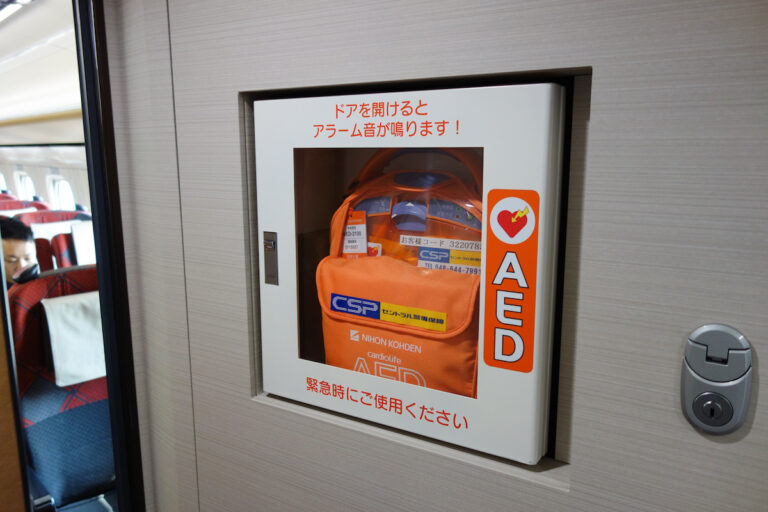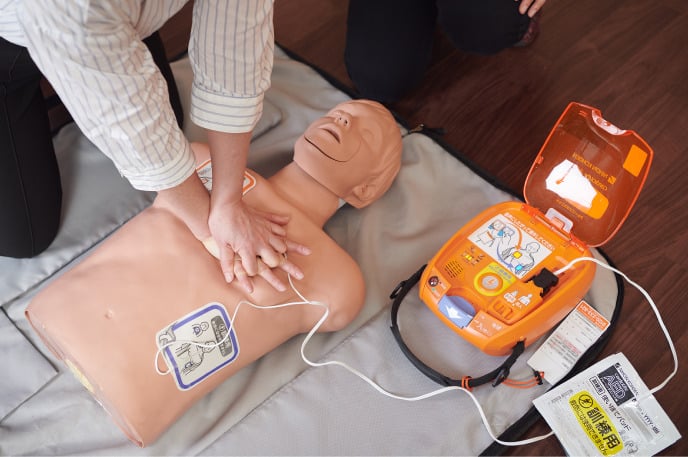
An AED (Automated External Defibrillator) is a medical device used to restore the heart to its normal rhythm by delivering an electric shock to the heart when it is convulsing and has lost its ability to pump blood (ventricular fibrillation).
What is often misunderstood is that an AED is used to restart a stopped heart. This is not the case. While an AED device cannot restart a flatlining heart, what they can do is to correct a heart that is still beating, albeit abnormally.
An AED analyzes the heart’s electrical signal and determines that an electric shock is necessary only in the case of arrhythmia. If there is no heartbeat, abnormal or not, a shock will not benefit the patient and the AED will not tell you to deliver one.
The point of an AED is to simplify a high-skill lifesaving medical procedure so that ordinary people with minimal training can administer care. The flipside of this is that you will still have to perform basic life support, as the AED on its own cannot, for instance, give chest compressions or mouth-to-mouth resuscitation.
AEDs in Japan come with Japanese voice-guided instructions on how to operate them. And so it is imperative to learn a few phrases and their instructions. More on this later.

When should you use an AED?
You should use an AED if someone is:
- Unconscious
- Does not respond to loud voice or tapping on the shoulders
- Shows no signs of breathing (within 10 seconds)
This is a medical emergency that requires immediate intervention. Call for an ambulance, begin giving chest compressions and mouth-to-mouth resuscitation, and find an AED.
How do you use an AED?
Open the AED – Some may automatically start and give voice instructions upon opening the lid. These instructions are redundant; it is not necessary to wait for the voice instructions to finish playing to begin placing the two pads on the body.
Place two pads on the body – Inside the AED device, there will be two rectangular pads attached with wires to the device. These pads may be inside disposable packaging that you have to open. In either case, the pads are immediately identifiable by the cable they are attached to. They function like stickers so you will have to peel off the cover to reveal the adhesive side. On the surface of these pads, there will be one image each that shows the specific part of the body they should be placed on (one towards the upper chest, and one lower near the ribs).
Be sure to place the pads firmly on the surface of the skin (wipe away any sweat). If the pads are not already connected to the AED machine, you will have to insert the plug into the power socket on the machine. The AED will automatically analyze the patient’s heart once the pads are placed, so there is no need to press a button.
Continue giving chest compressions and mouth-to-mouth resuscitation, until you hear this specific voice instruction:
Stay clear of the body – when you hear karada ni sawaranaide kudasai (体に触らないでください), do not make contact with the body.
Wait for the next voice instruction:
Electric shock is necessary – when you hear denki shokku ga hitsuyō desu (電気ショックが必要です) it means an electric shock is necessary. The AED will then take a moment to charge the pads. When it is done charging, you may be instructed to press the shock button. When you hear tenmetsu botan wo oshite kudasai (点滅ボタンを押してください) it is instructions for you to press the button with the flashing light. Pressing this button will deliver an electric shock. After this, the voice instructions may say denki shokku wo okonaimashita (電気ショックを行いました) which means the electric shock has been delivered.
Resume CPR – when you hear karada ni sawatte mo daijōbu desu (体に触っても大丈夫です) it means it is safe to touch the body. Immediately resume administering chest compressions and mouth-to-mouth resuscitation. The AED will instruct you to do this when you hear kyoukotsu appaku (胸骨圧迫 – chest compression) and jinkō kokyū (人工呼吸 – mouth-to-mouth resuscitation).
If electric shock is unnecessary – when you hear denki shokku ga fuhitsuyō desu (電気ショックが不必要です) it means the AED has determined that an electric shock is unnecessary. This does not mean that the patient will be okay. Upon hearing this, immediately begin giving chest compressions and mouth-to-mouth resuscitation.
Some newer AEDs do not have a shock button; they will administer a shock automatically, so you may only need to stay clear of the body.

Where can AEDs be found?
Since July 2004, AEDs have been available to the general public, including non-medical personnel, and are installed in hospitals, clinics, ambulances, airports, train stations, sports clubs, schools, public facilities, businesses, and other places where many people gather.
Signs for AEDs are typically displayed with the letters “AED” and a symbol of a heart with an electric bolt.
An AED map can be found here: https://aedm.jp/
Mobile app versions of this map can be found on the Google Play Store and Apple App Store:
Depending on the AED, some will sound an alarm when you take them out of the box they are stored in. This is completely normal. In an emergency, return immediately to the victim with the AED in hand.
Being prepared is the best way to ensure you can act swiftly in an emergency so it is recommended that you pay attention to and learn where AEDs are around the places you frequent.
How vital is its use?
The success rate of restoring a normal heartbeat rhythm through electroshock defibrillation decreases by approximately 7-10% with each passing minute following ventricular fibrillation.
In Japan, the average time to arrival of an ambulance is about 8.7 minutes. This puts the success rate of electroshock defibrillation at 8 minutes at 20%. Slim margins like these provide a strong case for learning how to use AEDs.
The stress of a situation is something that is not immediately obvious until you have to attempt to save someone’s life. Being well-rehearsed and informed will allow you the presence of mind to administer aid with an AED quickly and efficiently. Good luck!















